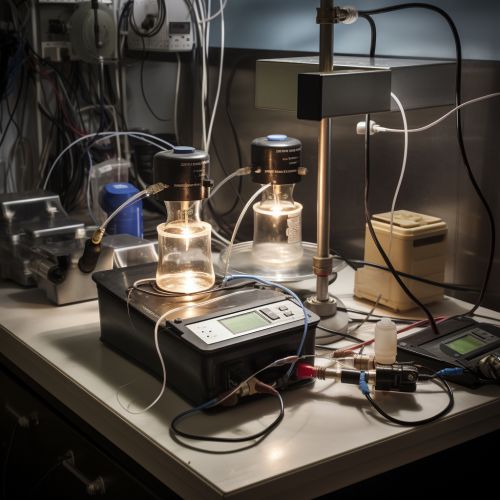Faraday's laws of electrolysis
Introduction
Faraday's laws of electrolysis are fundamental principles that govern the process of electrolysis, a method of separating bonded elements and compounds by passing an electric current through them. These laws were first proposed by the British scientist Michael Faraday in 1834 and have been instrumental in the development of numerous scientific fields, including electrochemistry, metallurgy, and industrial chemistry.


Faraday's First Law of Electrolysis
The first law of electrolysis states that the amount of a substance deposited or dissolved at an electrode during electrolysis is directly proportional to the quantity of electricity passed through the electrolyte. Mathematically, this law can be expressed as:
- m = ZQ
where:
- m is the mass of the substance deposited or dissolved,
- Z is the electrochemical equivalent of the substance (a constant for each substance), and
- Q is the total electric charge passed through the electrolyte.
This law implies that by measuring the amount of electricity (in coulombs) passed through the electrolyte, one can determine the amount of substance deposited or dissolved at the electrodes. This principle is used extensively in electroplating and electrorefining processes to deposit metals onto surfaces or to purify them.
Faraday's Second Law of Electrolysis
Faraday's second law of electrolysis states that when the same quantity of electricity is passed through several electrolytes, the mass of substances produced at the electrodes is directly proportional to their respective chemical equivalent or equivalent weight. This law can be mathematically expressed as:
- m1/m2 = E1/E2
where:
- m1 and m2 are the masses of two substances produced at the electrodes, and
- E1 and E2 are their respective equivalent weights.
This law is particularly useful in determining the equivalent weights of different substances, which is a critical parameter in many chemical reactions. It also underpins the concept of Faraday's constant, the amount of electric charge per mole of electrons.
Applications of Faraday's Laws of Electrolysis
Faraday's laws of electrolysis have numerous applications in various fields of science and industry. Some of these applications include:
- Electroplating: This is a process that uses electrolysis to deposit a layer of metal onto a surface. The amount of metal deposited and the thickness of the layer can be controlled by adjusting the amount of electric current and the time of electrolysis, as per Faraday's first law.
- Electrorefining: This is a method used to purify metals. It works by dissolving a metal anode in an electrolyte and then depositing a pure metal at the cathode. The process is governed by Faraday's laws, which dictate the amount of metal deposited at the cathode.
- Electrolytic synthesis: Electrolysis is used in the synthesis of various chemicals, such as chlorine, sodium hydroxide, and fluorine. The production of these chemicals is directly related to the amount of electricity passed through the electrolyte, as per Faraday's first law.
- Battery technology: Faraday's laws also play a crucial role in the operation of batteries. The amount of electricity that a battery can deliver before it needs to be recharged is determined by the amount of active material in the battery, which is related to the amount of charge passed through the battery during its charging process.
Conclusion
Faraday's laws of electrolysis are fundamental principles that have shaped our understanding of electrochemistry. They have numerous applications in various fields, from industrial processes like electroplating and electrorefining to the operation of batteries and the synthesis of chemicals. Despite being proposed over a century ago, these laws remain as relevant today as they were when Faraday first formulated them.
